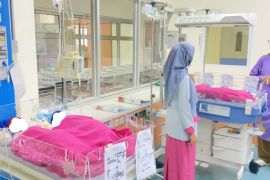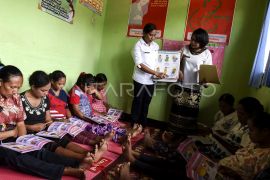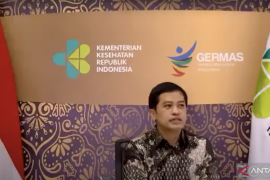Coordinating minister for people`s welfare Agung Laksono recently stated that the government had been committed to reducing the rate in line with the Millennium Development Goals (MDGs).
According to the government`s data, Indonesia`s maternal mortality rate (MMR) is currently at 228 per 100,000 living births, and it is trying to be reduced to 102 by 2015.
He admitted that currently the numbers of health facilities especially for delivery process and professional midwives were still not adequate especially in the regions and small islands.
"On remote islands it could take days to get access to health facilities or trained midwives," he said.
To help lower the country`s maternal and infant mortality rate, the government has decided to help indigent mothers get birth delivery services free of charge.
"The free delivery service is meant to reduce the maternal and infant mortality rate to achieve the MDG (Millennium Development Goals) target," Health Minister Endang Sedyawati said in Jakarta last March 2011.
The free services apply to deliveries that have happened with the help of midwives, at community health centers or in the third class wards of regional general hospitals, she said.
It would cover normal deliveries, deliveries through cesarean section or deliveries marked by medical complications.
The minister said the government had earmarked Rp1.2 trillion in budget funds to foot the medical bills of deliveries by mothers in the poor people category and those living in remote or isolated villages where the maternal and infant mortality rates were high.
During 2011, the free delivery services are expected to cover around 60 percent or 2.8 million of the total 4.8 million births nation-wide.
The government is also intensifying the implementation of the Family Planning program as another means to drop the maternal mortality rate.
"The Family Planning program can reduce the maternal death rate," Sugiri Syarief, head of the National Family Planning and Population Agency (BKKBN) said in Jakarta early March.
At least four unideal pregnancy conditions could lead to maternal death, namely: too young, too old, too many children and to frequent birth intervals.
Therefore, Family Planning program is necessary to control pregnancy by postponing and limiting pregnancies, Sugiri said.
The main causes of maternal death in Indonesia, which have a total population of around 237 million, are bleeding, abortion, post-eclampsia, infection and prolonged labor. While, other indirect factors include certain social-economic, education, and cultural levels, and transportation access.
"The government is intensifying the efforts to lower the maternal mortality rate among other things by boosting the Family Planning program," he said.
Minister Agung Laksono also recently confirmed that the government wanted to prevent maternal deaths through the revitalization of the Family Planning program.
Maternal health is one of the eight Millennium Development Goals (MDGs) which Indonesia has been committed since 2000.
But, Indonesia needs to work hard to achieve three targets of the MDGs, including maternal mortality rate and HIV/AIDS case reductions, according to National Development Planning Minister/Head of the National Development Planning Board (Bappenas) Armida S Alisjahbana.
"Indonesia has achieved a number of progresses in MDGs," the minister said in December 2010 when promoting and facilitating an action plan for regional MDGs achievement acceleration programs.
MDGs cover eight targets, namely: to eradicate extreme poverty and hanger; achieve universal primary education; promote gender equality and empower women; reduce child mortality; improve maternal health; combat HIV/AIDs, Malaria and other diseases; ensure environmental sustainability; and to develop a global partnership for development.
"All the goals are expected to be achieved by 2015. In 2011, there is a regional action plan to speed up the achievement of MDGs. We still have four years. Hopefully we could catch up with it," she said.
However, an expert has warned that the country might not be able to achieve the MDGs if the government did not take comprehensive steps such as improving the infrastructure that could help the public get access to health services.
"How they could access the health services if there is no road to go there," Head of the University of Gadjah Mada (UGM)`s Health Service Management Center Laksono Trisnantoro said recently in a discussion on "The Outlook oF Maternal and Infant Health Policies" in Jakarta.
In many remote areas, people could not reach even the nearest health community centers because there are no roads, no vehicles or the road condition is very poor, he said.
Another problem facing Indonesia is the lack of obstetricians and gynaecologists.
"At present, the current ratio of obstetricians and gynecologists is 1:26,000 people. Under this condition, it`s very difficult for us to reduce the maternal mortality rate," Chairman of the obstetricians and gynecologists association Dr. dr. Soegiarto Soebijanto, Sp.OG said in Pekanbaru, Riau, recently.
While in other ASEAN (Association of South East Asian Nations) member countries such as the Philippines, the ratio is 1 : 2,000.
Lack in the number of skilled midwives is also grave concern in Indonesia. About 30,000 villages of the country`s total 85,000 villages, have no trained midwives.
In remote areas, where there is no trained midwives, birth deliveries are usually handled by traditional midwives who are untrained and have no adequate and proper equipment as well as medicines.
Infection is a common cause of maternal death due to unsterilized delivery process, Mrs. Dedi Kuswandi of the Health Development Directorate said in Banjarmasin, South Kalimantan, recently.
According to Women`s International Network News figures, the number of maternal deaths worldwide per 100,000 live births is 430, with a sharp division between developing countries, where the maternal mortality ratio is estimated to be 480, and developed countries, where the ratio is 27. (*)
Reporter: Fardah
Editor: Aditia Maruli Radja
Copyright © ANTARA 2011










